- Joined
- Feb 26, 2009
- Messages
- 277,087
- Reaction score
- 8
If you’re a pike angler and especially If you’ve got a boat, this is for you…The Trollernoster is a method that’s accounted for a very substantial number of big pike for that unsung hero of pike-fishing, Tony Corless, Chigwell Man personified and a fine fisherman to boot. I have known Tony since boyhood and still keep in touch despite now living over 200 miles apart. How his poor body has tolerated so many late, boisterous nights down at his local club followed by dawn arrivals at god-forsaken venues 120 miles from home – I’ll never know.
Long before I made the move west, I’d occasionally get the chance to join him on his boat, moored on the Yare in the Norfolk Broads and always ready for some weekend action. But Tony had had far more river-piking experience than me so I was largely in his hands as far as methodology was concerned. He showed me the way he and his regular piking pals had taken, over the years, an enormous number of superb specimens from rivers, lakes and reservoirs – and I am talking big 30lbers here!
A rig incorporating some lead was required to keep everything down and, normally, close to the bottom, especially in flowing water where the boat’s drift would naturally raise an unweighted or under-weighted rig too high in the water column.
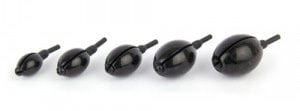
Fox Rage Predator Quick-Change Weights
To present the bait – live or dead but preferably live – naturally, and at a constant level, a sunken float and a paternoster was required but, of course, a paternoster trace does have a habit of fouling a rig, so a John Roberts mini-boom was employed in order to keep the two components of the rig apart – and it worked very well.
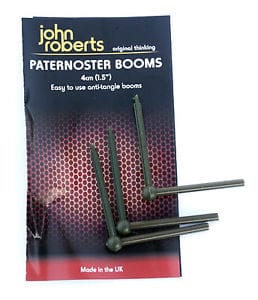
Trying to explain verbally OR in print why this ploy was so much more effective than using the boom in the ‘L’ position is near impossible, especially if you happen not to be a mathematician or an engineer: suffice to say that it works particularly well. Try it. Compare the two and you’ll see for yourself!
So, this rig allows the bait to be presented in any depth, and at any level depending on the length of the paternoster trace. There is an alternative in the shape of the Greys Prowla 360 Rotary Paternoster Boom which incorporates an adjustable-length lead-link and all associated hardware, swivels, links etc., and this does a really good, professional job; some might say too professional given its slick, almost-too-perfect-to-be-true design!
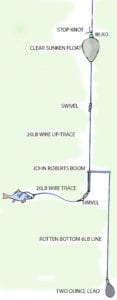
Sunken paternoster rig. Note wire up-trace and rotten bottom. This rig, endlessly drifted along the rivers of Norfolk and trolled around dozens of the UK’s reservoirs, has accounted for literally dozens of 20lb and 30lb pike. Tony Corless’s pal, ‘The Doctor’, used it to take twenty-seven 20lb+ pike including five 30s in one season.
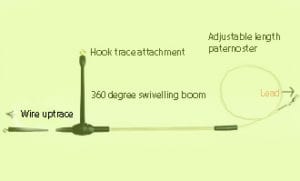
Greys Prowla 360 Degree Rotary Paternoster Boom. To use, add up-trace, lead, wire hook-trace armed with two trebles for large baits or a big single for smaller, lip-hooked baits.
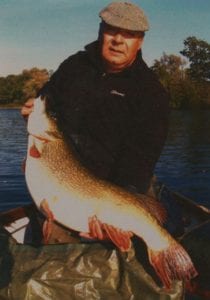
Tony Corless with a big ‘un.
There is no need to cast; you merely drop the rig over the back of the boat and pay-out perhaps ten yards of line to distance the intrusive craft from the business-end; you then allow the boat to drift with the river. The live or dead bait will have been mounted head-up on two trebles (or a single at the top and a treble below) to keep things streamlined and less likely to rise too high in a flow.
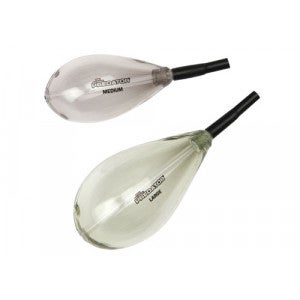
Greys Prowla Sunk Paternoster Floats
With the boat slowly drifting, the sunken float keeps everything pretty much perpendicular and civilized as the 1.5 – 2.0oz lead trips along the bottom (see diagram)
The Trollernoster is not a fast water rig. It is best employed on slow rivers and on large still waters where the rig can be very slowly led around by prudent use of the oars or just used static from boat or bank.
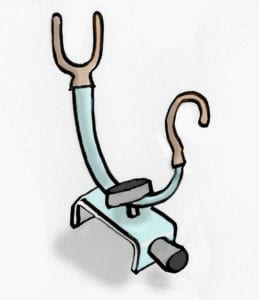
An experienced eye will know when the bait has been snatched but, to make absolutely sure of retaining an unsecured rod, bait-runners are engaged to give line when necessary; best to use an outrigger ‘rod-rest’ – preferably with a swivel facility to facilitate close-in trolling – of the type Tony Corless invented 40 years ago – so he tells me – and is now commercially manufactured.
Happy hunting!
Cliff Hatton.
Source Article...
Long before I made the move west, I’d occasionally get the chance to join him on his boat, moored on the Yare in the Norfolk Broads and always ready for some weekend action. But Tony had had far more river-piking experience than me so I was largely in his hands as far as methodology was concerned. He showed me the way he and his regular piking pals had taken, over the years, an enormous number of superb specimens from rivers, lakes and reservoirs – and I am talking big 30lbers here!
A rig incorporating some lead was required to keep everything down and, normally, close to the bottom, especially in flowing water where the boat’s drift would naturally raise an unweighted or under-weighted rig too high in the water column.

Fox Rage Predator Quick-Change Weights
To present the bait – live or dead but preferably live – naturally, and at a constant level, a sunken float and a paternoster was required but, of course, a paternoster trace does have a habit of fouling a rig, so a John Roberts mini-boom was employed in order to keep the two components of the rig apart – and it worked very well.

Trying to explain verbally OR in print why this ploy was so much more effective than using the boom in the ‘L’ position is near impossible, especially if you happen not to be a mathematician or an engineer: suffice to say that it works particularly well. Try it. Compare the two and you’ll see for yourself!
So, this rig allows the bait to be presented in any depth, and at any level depending on the length of the paternoster trace. There is an alternative in the shape of the Greys Prowla 360 Rotary Paternoster Boom which incorporates an adjustable-length lead-link and all associated hardware, swivels, links etc., and this does a really good, professional job; some might say too professional given its slick, almost-too-perfect-to-be-true design!

Sunken paternoster rig. Note wire up-trace and rotten bottom. This rig, endlessly drifted along the rivers of Norfolk and trolled around dozens of the UK’s reservoirs, has accounted for literally dozens of 20lb and 30lb pike. Tony Corless’s pal, ‘The Doctor’, used it to take twenty-seven 20lb+ pike including five 30s in one season.

Greys Prowla 360 Degree Rotary Paternoster Boom. To use, add up-trace, lead, wire hook-trace armed with two trebles for large baits or a big single for smaller, lip-hooked baits.

Tony Corless with a big ‘un.
There is no need to cast; you merely drop the rig over the back of the boat and pay-out perhaps ten yards of line to distance the intrusive craft from the business-end; you then allow the boat to drift with the river. The live or dead bait will have been mounted head-up on two trebles (or a single at the top and a treble below) to keep things streamlined and less likely to rise too high in a flow.

Greys Prowla Sunk Paternoster Floats
With the boat slowly drifting, the sunken float keeps everything pretty much perpendicular and civilized as the 1.5 – 2.0oz lead trips along the bottom (see diagram)
The Trollernoster is not a fast water rig. It is best employed on slow rivers and on large still waters where the rig can be very slowly led around by prudent use of the oars or just used static from boat or bank.

An experienced eye will know when the bait has been snatched but, to make absolutely sure of retaining an unsecured rod, bait-runners are engaged to give line when necessary; best to use an outrigger ‘rod-rest’ – preferably with a swivel facility to facilitate close-in trolling – of the type Tony Corless invented 40 years ago – so he tells me – and is now commercially manufactured.
Happy hunting!
Cliff Hatton.
Source Article...
Last edited by a moderator:
